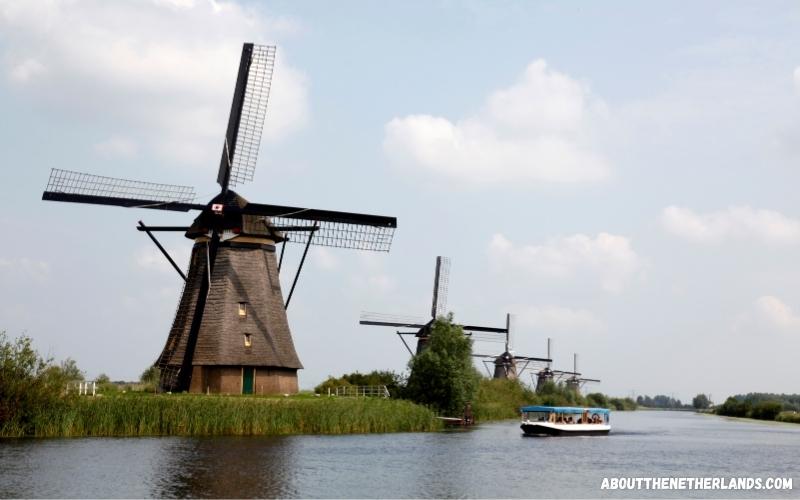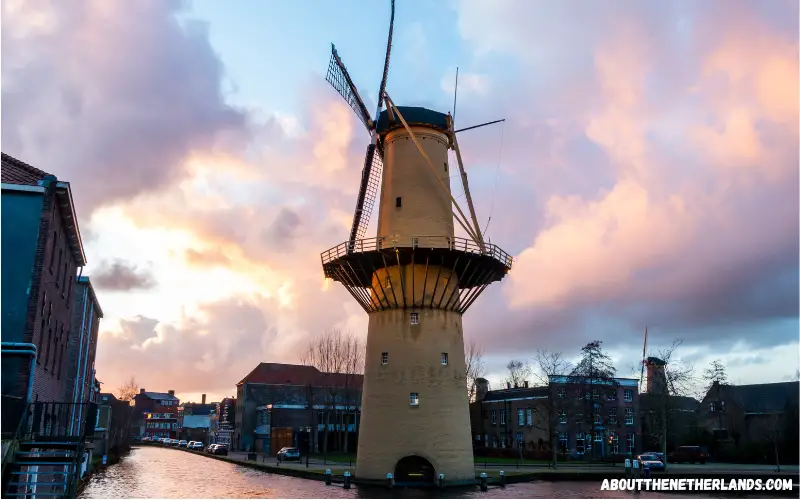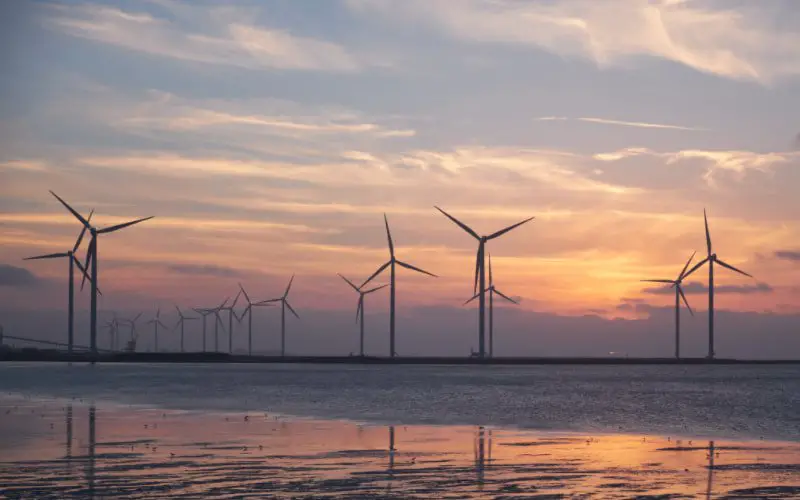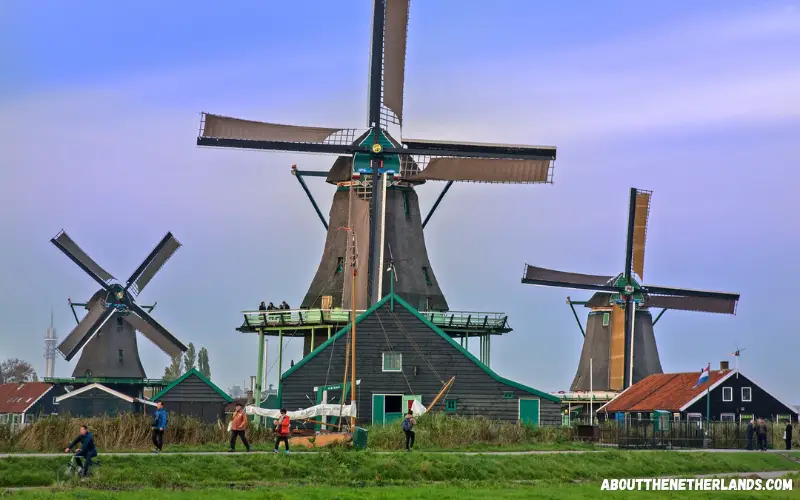

The Netherlands is, of course, known for its windmills, as tourists come from all over the world to visit one of the many iconic windmills in this country. The windmill has become a significant part of Dutch culture and forms a significant part of the Dutch tourist industry.
But why are there so many windmills in The Netherlands? What were they used for, and are they still in use today?
Let’s take a closer look at why there are windmills in The Netherlands!
First and foremost, windmills in the Netherlands serve the purpose of keeping important farmland dry. The Netherlands has had water troubles for centuries, as most of the country is situated below sea level.
Significant issues can occur when it comes to flooding of river banks or other water-related threats. In the worst-case scenario, farmland can flood, ruining the harvest for an entire year. Back in the day, this doomsday scenario used to be common practice in The Netherlands until they came up with a clever solution, you guessed it, windmills!
Windmills were used by the Dutch to pump water away from the farmland and back into the river. This is done by attaching the rotating blades of the windmill to a complex system of gears and connections that eventually lead to a rotating wheel with scoops attached. These scoops then push the water upstream, back to the river it came from.
Sometimes several windmills in a row were needed to keep a single patch of farmland safe and dry, hence the reason why we see so many windmills in rural territories of The Netherlands.
Nowadays, we have complex electrical machinery to do this task. However, most windmills are still standing proud in the countryside to uphold the beauty of Dutch culture.
A famous example of windmills used for the draining of farmland can be found in the Dutch town of Kinderdijk. This town is home to a group of 19 windmills and is actually considered a UNESCO world heritage site!

The agricultural use of windmills in The Netherlands doesn’t stop there, though. Windmills can also be used as a central pumps to power an irrigation system.
By attaching the windmill to a large system of pipes, using the same scooping system we saw earlier, water can be pumped through these pipes to all outskirts of the farmland. A setup like this can be used to irrigate farmland using solely wind power without any human intervention.
Similar to the draining of water, though, we also have complex modern machinery that has replaced the old-fashioned windmill for irrigation.
The invention of windmills used in irrigation was a great step forward in technological advancements back in the day, though, as it allowed farmers to focus more on the specific details of their farming, as the tedious task of irrigating acres of land was now automated.
This one may sound a little surprising, as how can land be reclaimed? But the Dutch have come to master this art over the years, and it all started with windmills.
Land can be reclaimed by pumping out significant amounts of water from a certain body of water. Once you’re done, you are left with a strip of usable land for a variety of purposes.
Windmills can be attached to a large rotating wheel of scoops, and by placing several windmills in a row, entire lakes can be pumped empty. Many pieces of land that used to be underwater have been reclaimed with the help of windmills.
Another common use for windmills back in the day was grain milling. By attaching the blades of a windmill to a large rotating plate using a complex gearing system, it is possible to create a massive grinding stone.
Placing unprocessed grain under this rotating stone could be milled down to a powder for use in the bakery. This is why high-end bakeries often had their own windmill associated with them. The word "milling" is actually derived from the fact that this process used to be done using windmills.
The processed grain can be used for baking bread or processing alcoholic beverages. The largest windmills in the world, which can be found in Schiedam in The Netherlands, were used to mill grain. These massive windmills could reach up to 42m in height! Which makes them some of the most famous windmills in The Netherlands.
Windmills are sadly no longer in use for this purpose, as once again, they’ve been replaced by more efficient electrical machinery.

We have now seen a specific example in which windmills were used as a part of the production of bread and alcoholic beverages, but windmills are actually a part of many more production processes. The conversion of wind energy into mechanical energy is useful for producing many different products.
Wood sawing:
Wooden planks used to be made using windmills. By attaching a complex gearing system to the mill’s rotating blades, wind energy can be converted into rotational kinetic energy.
By connecting a saw to this system, one can use wind power to cut large wooden logs into smaller wooden planks with significantly reduced human labor! Nowadays, complex electrical machinery has taken over this task.
Making paint:
Surprisingly, paints and dyes are also used to be made using windmills. The production of paint requires ingredients to be milled into powder, and what better way to use this than using a windmill?
Furthermore, the rotational energy created by a windmill can also be used to mix large quantities of ingredients together to form different colors. Once again, using windmills saves a significant amount of intensive human labor but has since been replaced by more modern electrical counterparts.
Producing oils:
Windmills were also used to extract natural oils from things like seeds and plants. It is possible to create a wind-powered press by slightly altering the previously mentioned gearing system.
This press can then be used to firmly compress the seeds, which leads to them excreting the precious oils. These oils are often used in a variety of products, such as skin care products or plant-based food products.
An obvious use of windmills in today's day and age is, of course, generating electricity. This is a more modern use of windmills, which is still very much being used today.
By attaching the rotating blades of a windmill to a dynamo, wind energy can be converted into electrical energy. This electrical energy can then be stored in large batteries and transferred to households or other places where it is needed.
The Netherlands is home to multiple large windmill parks that are designed specifically for this purpose, both outside the Dutch coastline and in the rural countryside. However, these specific windmills are modern variants of their old-fashioned counterparts, so they do not really fit into the aesthetically pleasing picture of the old-fashioned Dutch windmill.
That does not make them any less useful, though, as 12% of Dutch power is currently supplied through wind energy!

We have now looked at a significant amount of windmill uses in the Netherlands, but many of these uses are now outdated and are no longer in use. So, why are there still so many windmills in the Netherlands?
This is due to the fact that nowadays, most of the old, redundant windmills have been turned into museum exhibits that you can visit. Some are still entirely operational, and visiting one of these museum mills is the perfect way to indulge yourself in Dutch culture.
Breaking down old windmills would be a shame for the cultural meaning that they carry, so turning them into museum sites is the best option for them to still have a use.

All in all, windmills were used for many things in the Netherlands, ranging from draining farmland to electricity generation and alcohol production!
Nowadays, only a few windmills still serve an active purpose in society, but many have been turned into museum exhibits for you to visit. If you want to experience the true taste of Dutch culture, it doesn't get much better than a proper old-fashioned windmill!
If you would like to know more about windmills in The Netherlands, be sure to read my article with facts about Dutch windmills!